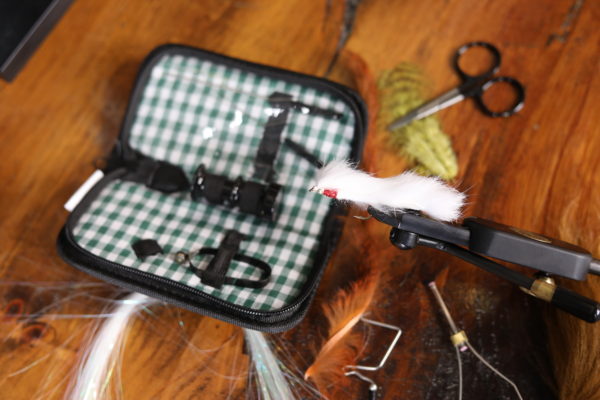Out of all my fishing buddies I’m one of the few that actually looks forward to fly fishing in the middle of winter. Sure, chunks of half-submerged ice and line frozen in my rod guides isn’t all that pleasant, but it’s decidedly better than not fishing.
That said, winter only gives you a few hours to fish. Days short on light and long on cold temperatures can easily ruin the best-laid plans. When that happens to me, I retreat inside, turn on some stand-up comedy or reruns of That ’70s Show, and start tying flies.
Winter is the best time of year to get started with fly tying. Fewer fishing opportunities means less temptation to leave the tying bench for “just a few hours” on the river. If you’ve never tied flies, though, getting started is intimidating. What materials and gear do you need, and what can you easily go without? In many ways, tying flies is a lot like learning to fly fish.
What you absolutely need
There’s an old saying that goes something like this: anglers use new and different flies exponentially as they learn the sport, stuffing dozens of boxes full of patterns they don’t remember buying. After a few years, though, they realize they fish about a dozen or so flies and stick to tying those bugs.
From personal experience, I’ll tell you that’s true. When I started fishing I bought flies just to have them. I didn’t take the time to look at a fly and ask myself if it was tied to catch fish or fishermen. As my good buddy (and world-champion angler for Fly Fishing Team USA) Lance Egan says, you have to tie some flies with bin appeal.
That said, the flies you fish are likely the same as what you’ll find in my box – caddis, hare’s ears, pheasant tails, Frenchies, zebra midges, black woolly buggers, and the venerable parachute Adams. Those flies will work anywhere in the country – if not most of North America – and to tie them you need just a few items:
- A tying vise. For years, I used one my grandpa used throughout most of the 60s. I just recently upgraded, and only then because the jaws on that old vise were finally shot.
- Whip finish tool, ceramic bobbin, and sharp tying scissors. Postfly makes a nice travel-ready fly tying tool kit with all the essential tools for under $50 here.
- Tying cement
- Black, brown, gray, green, and red Ultra UTC 70-denier tying thread. At a whopping $1.50ish a spool, you can grab 10 of these without breaking the bank. If I had to downsize all of my thread to one size and color, though, it’d be the five listed here. (If you want to spend a bit more, 50-denier Semper Fli Nano Silk is worth the investment. Best thread I’ve ever used.)
- Elk hair
- Pheasant tails
- Medium and small UTC copper and silver wire (again, $1.50ish per spool)
- Black strung marabou
- Umpqua TMC Tiemco 101 & 100 hooks sizes 8 – 18. The TMC Tiemco hooks are a bit more expensive than cheaper options like Mustad, but I’ve never once had a Tiemco hook break or straighten out on me. They’re worth the extra cost.
- Half-saddle of Metz or Whiting grizzly hackle
- Half-saddle of Metz or Whiting brown hackle
- Black bugger hackle
- Brown, gray, pale yellow, and orange dubbing
- 2.0, 2.1, and 2.3mm brass beads
- White Antron yarn
Those supplies will easily set you up to tie at least 12 dozen flies. If you’ve tied before, or learn quickly, you can stretch that to 20 dozen flies no problem.
What patterns should I start with?
The zebra midge should be your first fly. It’s simple, quick, and catches fish. It’s pretty hard to mess up this trusty pattern.
Then I’d move on to the elk hair caddis and Frenchie. Throw in a pheasant tail and a parachute Adams, and you have a box of dries and nymphs that’ll catch fish more often than not. If you are looking for more inspiration, try Postfly’s fly tying subscription, which will deliver new materials and instructions for a new pattern each month.
Watch a ton of videos
I learned to tie from Jack Dennis’s book, Great Western Trout Flies, Vol. 2. Learning to tie from black-and-white photos isn’t as easy as watching the stellar tying videos from Tight Line Video. The tutorials are simple, easy to follow, and the flies are patterns that actually work.
Winter is a great time to start tying. With the extra time winter provides – and the desire to do something fly fishing related when it’s just too cold outside to fish for most folks – this is the perfect time of year to hone your skills and start catching trout on flies you’ve tied yourself.
Spencer Durrant is a fly fishing writer, outdoors columnist, and novelist from Utah. His work has appeared in Field & Stream, Hatch Magazine, Sporting Classics Daily, and other national publications. Find him on Twitter/Instagram, @Spencer_Durrant.


2 thoughts on “How to Get Started Tying Flies this Winter”